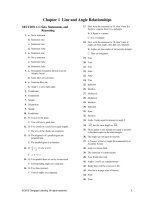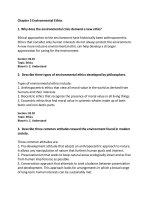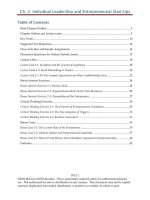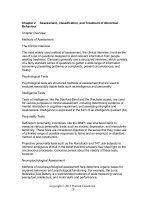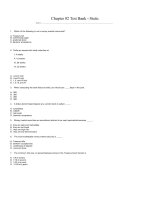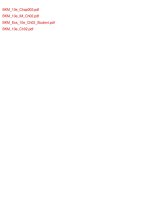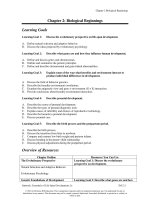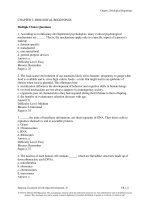Solution manual of ch02 line and angle relations
Bạn đang xem bản rút gọn của tài liệu. Xem và tải ngay bản đầy đủ của tài liệu tại đây (480.96 KB, 21 trang )
Chapter 1 Line and Angle Relationships
SECTION 1.1: Sets, Statements, and
Reasoning
17. First, write the statement in “If, then” form. If a
figure is a square, then it is a rectangle.
H: A figure is a square.
1. a. Not a statement.
b. Statement; true
c. Statement; true
C: It is a rectangle.
18. First, write the statement in “If, then” form. If
angles are base angles, then they are congruent.
d. Statement; false
H: Angles are base angles of an isosceles triangle.
2. a. Statement; true
C: They are congruent.
b. Not a statement.
19. True
c. Statement; false
20. True
d. Statement; false
21. True
3. a. Christopher Columbus did not cross the
Atlantic Ocean.
b. Some jokes are not funny.
4. a. Someone likes me.
b. Angle 1 is not a right angle.
5. Conditional
6. Conjunction
7. Simple
8. Disjunction
9. Simple
10. Conditional
11. H: You go to the game.
C: You will have a great time.
12. H: Two chords of a circle have equal lengths.
C: The arcs of the chords are congruent.
13. H: The diagonals of a parallelogram are
perpendicular.
C: The parallelogram is a rhombus.
14. H: a = c ( b ≠ 0, d ≠ 0 )
b d
C: a ⋅ d = b ⋅ c
15. H: Two parallel lines are cut by a transversal.
C: Corresponding angles are congruent.
16. H: Two lines intersect.
C: Vertical angles are congruent.
22. False
23. False
24. True
25. Induction
26. Intuition
27. Deduction
28. Deduction
29. Intuition
30. Induction
31. None
32. Intuition
33. Angle 1 looks equal in measure to angle 2.
34.
AM has the same length as MB .
35. Three angles in one triangle are equal in measure
to the three angles in the other triangle.
36. The angles are not equal in measure.
37. A Prisoner of Society might be nominated for an
Academy Award.
38. Andy is a rotten child.
39. The instructor is a math teacher.
40. Your friend likes fruit.
41. Angles 1 and 2 are complementary.
42. Kathy Jones will be a success in life.
43. Alex has a strange sense of humor.
44. None
45. None
© 2015 Cengage Learning. All rights reserved.
1
2
Chapter 1: Line and Angle Relationships
46. None
b. 2 1
2
47. June Jesse will be in the public eye.
48. None
18. a. 1.5
b. 5
49. Marilyn is a happy person.
50. None
19. a. 40°
b. 50°
51. Valid
52. Not valid
20. a. 90°
53. Not valid
b. 25°
54. Valid
21. Congruent; congruent
55. a. True
22. Equal; yes
b. True
23. Equal
c. False
24. 2 inches
56. a. False
25. No
b. False
26. Yes
57. a. True
27. Yes
b. True
28. No
29. Congruent
SECTION 1.2: Informal Geometry and
Measurement
30. Congruent
31. MN and QP
1. AB < CD
32. Equal
2. m∠ABC < m∠DEF
33.
3. Two; one
34. ∠ABD
4. No
35. 22
5. One; none
36. 14
6. Three
37.
x + x + 3 = 21
2 x = 18
x=9
38.
x+ y
7. ∠ABC , ∠ABD , ∠DBC
8. 23°, 90°, 110.5°
9. Yes; no; yes
10. A-X-B
11. ∠ABC , ∠CBA
12. Yes; yes
13. Yes; no
14. a, d
15. a, d
16. R; they are equal.
AB
39. 124°
40. 2 x + x = 180
3x = 180
x = 60
m∠1 = 120D
41. 71°
42. 34°
43.
x + 2 x + 3 = 72
3x = 69
x = 23
44.
x+ y
17. a. 3
© 2015 Cengage Learning. All rights reserved.
Section 1.3
45. 32.7 ÷ 3 = 10.9
3
HJJG
11. CD means line CD;
CD means segment CD;
46.
CD means the measure or length of CD ;
JJJG
CD means ray CD with endpoint C.
12. a. No difference
b. No difference
47.
48.
x + y = 180
x − y = 24
= 204
2x
x = 102
y = 78
x + y = 67
x − y = 17
= 84
2x
x = 42
y = 25
49. N 22° E
50. S 66° E
SECTION 1.3: Early Definitions and
Postulates
1. AC
2. Midpoint
3. 6.25 ft ⋅ 12 in./ft = 75 in.
4. 52 in. ÷ 12 in./ft = 4 1 ft or 4 ft 4 in.
3
5.
1 m ⋅ 3.28 ft/m = 1.64 feet
2
6. 16.4 ft ÷ 3.28 ft/m = 5 m
7. 18 – 15 = 3 mi
8. 300 + 450 + 600 = 1350 ft
1350 ft ÷ 15 ft/s = 90 s or 1 min 30 s
9. a. A-C-D
b. A, B, C or B, C, D or A, B, D
10. a. Infinite
b. One
c. None
d. None
© 2015 Cengage Learning. All rights reserved.
c. No difference
JJJG
d. CD is the ray starting at C and going to the
right.
JJJG
DC is starting at D and going to the left.
13. a. m and t
b. m and p or p and t
14. a. False
b. False
c. True
d. True
e. False
15. 2 x + 1 = 3x − 2
− x = −3
x=3
AM = 7
16. 2( x + 1) = 3( x − 2)
2 x + 2 = 3x − 6
−1x = −8
x =8
AB = AM + MB
AB = 18 + 18 = 36
17. 2 x + 1 + 3x = 6 x − 4
5x + 3 = 6 x − 4
−1x = −7
x=7
AB = 38
18. No; Yes; Yes; No
JJJG
JJJG
19. a. OA and OD
JJJG
JJJG
b. OA and OB (There are other possible
answers.)
HJJG
20. CD lies on plane X.
4
Chapter 1: Line and Angle Relationships
21. a.
HJJG
23. Planes M and N intersect at AB .
24. B
25. A
26. a. One
b.
b. Infinite
c. One
d. None
27. a. C
c.
b. C
c. H
28. a. Equal
b. Equal
22. a.
c. AC is twice DC.
29. Given: AB and CD as shown (AB > CD)
Construct MN on line l so that
MN = AB + CD
b.
30. Given: AB and CD as shown (AB > CD)
Construct: EF so that EF = AB − CD .
c.
31. Given: AB as shown
Construct: PQ on line n so that PQ = 3( AB )
© 2015 Cengage Learning. All rights reserved.
Section 1.4
32. Given: AB as shown
Construct: TV on line n so that TV = 1 ( AB )
2
5
2. a. Obtuse
b. Straight
c. Acute
3. a. Complementary
b. Supplementary
4. a. Congruent
b. None
5. Adjacent
33. a. No
6. Vertical
b. Yes
7. Complementary (also adjacent)
c. No
8. Supplementary
d. Yes
9. Yes; No
34. A segment can be divided into 2n congruent
parts where n ≥ 1 .
10. a. True
b. False
35. Six
c. False
36. Four
d. False
37. Nothing
e. True
38. a. One
b. One
b. Straight
c. None
c. Acute
d. One
d. Obtuse
e. One
f. One
g. None
39. a. Yes
b. Yes
c. No
40. a. Yes
b. No
c. Yes
41.
11. a. Obtuse
1
1
2a + 3b
a + b or
3
2
6
SECTION 1.4: Angles and Their
Relationships
1. a. Acute
b. Right
c. Obtuse
© 2015 Cengage Learning. All rights reserved.
12. B is not in the interior of ∠FAE ; the AngleAddition Postulate does not apply.
13. m∠FAC + m∠CAD = 180
∠FAC and ∠CAD are supplementary.
14. a. x + y = 180
b. x = y
15. a. x + y = 90
b. x = y
16. 62°
17. 42°
18. 2 x + 9 + 3x − 2 = 67
5 x + 7 = 67
5 x = 60
x = 12
6
Chapter 1: Line and Angle Relationships
19. 2 x − 10 + x + 6 = 4( x − 6)
3x − 4 = 4 x − 24
20 = x
x = 20
m∠RSV = 4(20 − 6) = 56D
x + y = 90
x = 12 + y
26.
x + y = 90
x − y = 12
2x
= 102
x = 51
20. 5( x + 1) − 3 + 4( x − 2) + 3 = 4(2 x + 3) − 7
5 x + 5 − 3 + 4 x − 8 + 3 = 8 x + 12 − 7
9 x − 3 = 8x + 5
x =8
m∠RSV = 4(2 ⋅ 8 + 3) − 7 = 69D
21.
51 + y = 90
y = 39
x + y = 180
x = 24 + 2 y
27.
x x
+ = 45
2 4
x + y = 180
x − 2 y = 24
Multiply by LCD, 4
−2 x + 2 y = 360
x − 2 y = 24
3x
= 384
x = 128; y = 52
2x + x = 180
3x = 180
x = 60; m ∠ RST = 30۫
22.
2x x
+ = 49
3 2
∠s are 128° and 52°.
D
28. a. ( 90 − x )
Multiply by LCD, 6
b.
4x + 3x = 294
c. 90 − (2 x + 5 y ) = (90 − 2 x − 5 y )D
7x = 294
x = 42; m ∠ TSV =
23.
x
= 21۫
2
D
29. a. (180 − x )
b. 180 − (3x − 12) = (192 − 3x )D
x + y = 2x − 2 y
x + y + 2 x − 2 y = 64
−1x + 3 y = 0
3x − 1 y = 64
−3x + 9 y = 0
3x − y = 64
8 y = 64
y = 8; x = 24
24.
( 90 − (3x − 12) )D = (102 − 3x )D
2 x + 3 y = 3x − y + 2
2 x + 3 y + 3x − y + 2 = 80
−1x + 4 y = 2
5 x + 2 y = 78
c. 180 − (2 x + 5 y )
(180 − 2 x − 5 y )D
30.
x − 92 = 92 − 53
x − 92 = 39
x = 131
31.
x − 92 + (92 − 53) = 90
x − 92 + 39 = 90
x − 53 = 90
x = 143
32. a. True
b. False
c. False
−5 x + 20 y = 10
5 x + 2 y = 78
22 y = 88
y = 4; x = 14
25. ∠CAB ≅ ∠DAB
© 2015 Cengage Learning. All rights reserved.
Section 1.4
33. Given: Obtuse ∠MRP
JJJG
Construct: With OA as one side,
an angle ≅ ∠MRP .
7
37. For the triangle shown, the angle bisectors are
been constructed.
It appears that the angle bisectors meet at one
point.
38. Given: Acute ∠1
Construct: Triangle ABC which has
∠A ≅ ∠1 , ∠B ≅ ∠1 and base AB .
34. Given: Obtuse ∠MRP
JJJG
Construct: RS , the angle-bisector of ∠MRP .
39. It appears that the two sides opposite ∠ s A and B
are congruent.
40. Given: Straight angle ABC
Construct: Bisectors of ∠ABD and ∠DBC .
35. Given: Obtuse ∠MRP
Construct: Rays RS, RT, and RU so that ∠MRP
is divided into 4 ≅ angles.
It appears that a right angle is formed.
41. a. 90°
b. 90°
36. Given: Straight angle DEF
Construct: a right angle with vertex at E.
c. Equal
42. Let m ∠ USV = x , then m ∠ TSU = 38 − x
38 − x + 40 = 61
78 − x = 61
78 − 61 = x
x = 17; m ∠ USV = 17D
© 2015 Cengage Learning. All rights reserved.
8
Chapter 1: Line and Angle Relationships
43.
x + 2 z + x − z + 2 x − z = 60
4 x = 60
x = 15
If x = 15, then m ∠ USV = 15 − z ,
m ∠ VSW = 30 − z , and
m ∠ USW = 3 x − 6 = 3(15) − 6 = 39
So 15 − z + 2(15) − z = 39
45 − 2 z = 39
6 = 2z
z=3
17. 2 x = 10
18.
x=7
19. 7 x + 2 = 30
20.
1 = 50%
2
21. 6 x − 3 = 27
22.
x = −20
23. 1. Given
44. a. 52°
2. Distributive Property
b. 52°
3. Addition Property of Equality
c. Equal
4. Division Property of Equality
45. 90 + x + x = 360
2 x = 270
x = 135D
24. 1. Given
2. Subtraction Property of Equality
46. 90
3. Division Property of Equality
25. 1. 2( x + 3) − 7 = 11
SECTION 1.5: Introduction to
Geometric Proof
2. 2 x + 6 − 7 = 11
3. 2 x − 1 = 11
1. Division Property of Equality or Multiplication
Property of Equality
4. 2 x = 12
2. Distributive Property [ x + x = (1 + 1) x = 2 x ]
5. x = 6
3. Subtraction Property of Equality
4. Addition Property of Equality
26. 1. x + 3 = 9
5
5. Multiplication Property of Equality
2. x = 6
5
6. Addition Property of Equality
3. x = 30
7. If 2 angles are supplementary, then the sum of
their measures is 180°.
8. If the sum of the measures of 2 angles is 180°,
then the angles are supplementary.
9. Angle-Addition Property
10. Definition of angle-bisector
11.
AM + MB = AB
AM = MB
JJJG
13. EG bisects ∠DEF
12.
14. m∠1 = m∠2 or ∠1 ≅ ∠2
D
15. m∠1 + m∠2 = 90
16. ∠1 and ∠2 are complementary
27. 1. Given
2. Segment-Addition Postulate
3. Subtraction Property of Equality
28. 1. Given
2. The midpoint forms 2 segments of equal
measure.
3. Segment-Addition Postulate
4. Substitution
5. Distributive Property
6. Multiplication Property of Equality
29. 1. Given
2. If an angle is bisected, then the two angles
formed are equal in measure.
3. Angle-Addition Postulate
© 2015 Cengage Learning. All rights reserved.
Section 1.6
9
4. Substitution
5. Substitution
5. Distribution Property
6. If 2 ∠ s are = in measure, then they are ≅ .
6. Multiplication Property of Equality
30. 1. Given
2. The measure of a straight angle is 180°.
2. Angle-Addition Postulate
3. Angle-Addition Postulate
3. Subtraction Property of Equality
4. Substitution
31. S1. M-N-P-Q on MQ
5. Given
R1. Given
6. The measure of a right ∠ = 90D .
2. Segment-Addition Postulate
7. Substitution
3. Segment-Addition Postulate
8. Subtraction Property of Equality
4. MN + NP + PQ = MQ
9. Angle-Addition Postulate
JJJG
JJJG
32. 1. ∠TSW with SU and SV ; Given
2. Angle-Addition Postulate
3. Angle-Addition Postulate
4. m∠TSW = m∠TSU + m∠USV + m∠VSW
33. 5 ⋅ x + 5 ⋅ y = 5( x + y )
34. 5 ⋅ x + 7 ⋅ x = (5 + 7) x = 12 x
35. ( −7)( −2) > 5( −2) or 14 > −10
36.
2. 1. Given
12 < −4 or −3 < 1
−4 −4
10. Substitution
11. If the sum of measures of 2 angles is 90°, then
the angles are complementary.
3. 1. ∠1 ≅ ∠2 and ∠2 ≅ ∠3
2. ∠1 ≅ ∠3
4. 1. m∠AOB = m∠1 and m∠BOC = m∠1
2. m∠AOB = m∠BOC
3. ∠AOB ≅ ∠BOC
JJJG
4. OB bisects ∠AOC
5. Given: Point N on line s.
Construct: Line m through N so that m ⊥ s .
37. 1. Given
2. Addition Property of Equality
3. Given
4. Substitution
38. 1. a = b
1. Given
2. a – c = b – c
2. Subtraction Property of
Equality
3. c = d
3. Given
4. a – c = b – d
4. Substitution
SECTION 1.6: Relationships:
Perpendicular Lines
1. 1. Given
2. If 2 ∠ s are ≅ , then they are equal in
measure.
3. Angle-Addition Postulate
4. Addition Property of Equality
© 2015 Cengage Learning. All rights reserved.
JJJG
6. Given: OA
Construct: Right angle BOA
(Hint: Use the straightedge to
JJJG
extend OA to the left.)
10
Chapter 1: Line and Angle Relationships
7. Given: Line A containing point A
Construct: A 45° angle with vertex at A
15. No; Yes; No
16. No; No; Yes
17. No; Yes; Yes
18. No; No; No
19. a. perpendicular
b. angles
c. supplementary
8. Given: AB
Construct: The perpendicular bisector of AB
d. right
e. measure of angle
20. a. postulate
b. union
c. empty set
d. less than
e. point
21. a. adjacent
9. Given: Triangle ABC
Construct: The perpendicular bisectors of each
side, AB , AC , and BC .
b. complementary
c. ray AB
d. is congruent to
e. vertical
22. In space, there are an infinite number of lines
perpendicular to a given line at a point on the
line.
23.
STATEMENTS
REASONS
1. M − N − P − Q on MQ 1. Given
2. MN + NQ = MQ
2. Segment-Addition
Postulate
3. NP + PQ = NQ
3. Segment-Addition
Postulate
4. MN + NP + PQ = MQ 4. Substitution
3. Substitution
24.
AE = AB + BC + CD + DE
4. m∠1 = m∠2
25.
STATEMENTS
JJJG
1. ∠TSW with SU
JJJG
and SV
2. m∠TSW
= m∠TSU + m∠USW
3. m∠USW
= m∠USV + m∠VSW
4. m∠TSW = m∠TSU
+ m∠USV + m∠VSW
10. It appears that the perpendicular bisectors meet at
one point.
11. 1. Given
5. ∠1 ≅ ∠2
12. 1. Given
2. m∠1 = m∠2 and m∠3 = m∠4
3. Given
4. m∠2 + m∠3 = 90
REASONS
1. Given
2. Angle-Addition
Postulate
3. Angle-Addition
Postulate
4. Substitution
5. Substitution
26. m∠GHK = m∠1 + m∠2 + m∠3 + m∠4
6. ∠s 1 and 4 are comp.
27. In space, there are an infinite number of lines that
perpendicularly bisect a given line segment at its
midpoint.
13. No; Yes; No
14. No; No; Yes
© 2015 Cengage Learning. All rights reserved.
Section 1.7
28. 1. Given
2. If 2 ∠s are comp., then the sum of their
measures is 90°.
3. Given
4. The measure of an acute angle is between 0
and 90°.
5. Substitution
6. Subtraction Prop. of Eq.
7. Subtraction Prop. of Inequality
8. Addition Prop. of Inequality
9. Transitive Prop. of Inequality
10. Substitution
11. If the measure of an angle is between 0 and
90°, then the angle is an acute ∠ .
29. Angles 1, 2, 3, and 4 are adjacent and form the
straight angle AOB which measures 180.
Therefore, m∠1 + m∠2 + m∠3 + m∠4 = 180.
11
6. First write the statement in the “If, then” form. If
polygons are similar, then the lengths of
corresponding sides are proportional.
H: Polygons are similar.
C: The lengths of corresponding sides are
proportional.
7. Statement, Drawing, Given, Prove, Proof
8. a. Hypothesis
b. Hypothesis
c. Conclusion
9. a. Given
b. Prove
10. a, c, d
11. After the theorem has been proved.
12. No
HJJG HJJG
13. Given: AB ⊥ CD
Prove: ∠AEC is a right angle.
30. If ∠2 and ∠3 are complementary, then
m∠2 + m∠3 = 90. From Exercise 29,
m∠1 + m∠2 + m∠3 + m∠4 = 180. Therefore,
m∠1 + m∠4 = 90 and ∠1 and ∠4 are
complementary.
SECTION 1.7: The Formal Proof of a
Theorem
1. H: A line segment is bisected.
C: Each of the equal segments has half the length
of the original segment.
2. H: Two sides of a triangle are congruent.
C: The triangle is isosceles.
Figure for exercises 13 and 14.
14. Given: ∠AEC is a right angle
HJJG HJJG
Prove: AB ⊥ CD
15. Given: ∠1 is comp to ∠3
∠2 is comp to ∠3
Prove: ∠1 ≅ ∠2
3. First write the statement in the “If, then” form. If
a figure is a square, then it is a quadrilateral.
H: A figure is a square.
C: It is a quadrilateral.
4. First write the statement in the “If, then” form. If
a polygon is a regular polygon, then it has
congruent interior angles.
H: A polygon is a regular polygon.
C: It has congruent interior angles.
5. H: Each is a right angle.
C: Two angles are congruent.
© 2015 Cengage Learning. All rights reserved.
16. Given: ∠1 is supp to ∠3
∠2 is supp to ∠3
Prove: ∠1 ≅ ∠2
12
Chapter 1: Line and Angle Relationships
17. Given: Lines l and m
Prove: ∠1 ≅ ∠2 and ∠3 ≅ ∠4
3x + x = 480
4x = 480
x = 120; m ∠ 4 = 40۫
27. 1. Given
18. Given: ∠1 and ∠2 are right angles
Prove: ∠1 ≅ ∠2
2. If 2 ∠ s are comp., then the sum of their
measures is 90.
3. Substitution
4. Subtraction Property of Equality
5. If 2 ∠ s are = in measure, then they are ≅ .
19. m∠2 = 55D , m∠3 = 125D , m∠4 = 55D
20. m∠1 = 133D , m∠3 = 133D , m∠4 = 47D
21.
m∠1 = m∠3
3x + 10 = 4 x − 30
x = 40; m∠1 = 130D
22.
m∠2 = m∠4
6x + 8 = 7x
x = 8; m∠2 = 56D
23. m∠1 + m∠2 = 180D
2 x + x = 180
3x = 180
x = 60; m∠1 = 120D
24. m∠2 + m∠3 = 180D
x + 15 + 2 x = 180
3x = 165
x = 55; m∠2 = 110D
25.
x
x
+ 40 = 180
− 10 +
2
3
x
x
+
+ 30 = 180
2
3
28. Given: ∠1 is supp to ∠2
∠3 is supp to ∠2
Prove: ∠1 ≅ ∠3
STATEMENTS
REASONS
1. ∠1 is supp to ∠2 1. Given
∠3 is supp to ∠2
2. m∠1 + m∠2 = 180 2. If 2 ∠s are supp.,
m∠3 + m∠2 = 180
then the sum of their
measures is 180.
3. m∠1 + m∠2
3. Substitution
= m∠3 + m∠2
4. m∠1 = m∠3
4. Subtraction Property
of Equality
5. ∠1 ≅ ∠3
5. If 2 ∠s are = in
measure, then they
are ≅ .
29. If 2 lines intersect, the vertical angles formed are
congruent.
HJJG
HJJG
Given: AB and CD intersect at E
Prove: ∠1 ≅ ∠2
x x
+ = 150
2 3
Multiply by 6
3x + 2x = 900
5x = 900
x = 180; m ∠ 2 = 80۫
26. x + 20 +
x+
x
= 180
3
x
= 160
3
STATEMENTS
HJJG
HJJG
1. AB and CD
intersect at E
2. ∠1 is supp to ∠AED
∠2 is supp to ∠AED
3. ∠1 ≅ ∠2
REASONS
1. Given
2. If the exterior sides
of two adj. ∠s form
a straight line, then
these ∠s are supp.
3. If 2 ∠s are supp. to
the same ∠, then
these ∠s are ≅ .
Multiply by 3
© 2015 Cengage Learning. All rights reserved.
Section 1.7
30. Any two right angles are congruent.
Given: ∠1 is a rt. ∠
∠2 is a rt. ∠
Prove: ∠1 ≅ ∠2
13
32. If 2 segments are congruent, then their midpoints
separate these segments into four congruent
segments.
Given: AB ≅ DC
M is the midpoint of AB
N is the midpoint of DC
Prove: AM ≅ MB ≅ DN ≅ NC
STATEMENTS
REASONS
1. ∠1 is a rt. ∠
1. Given
∠2 is a rt. ∠
2. m∠1 = 90
2. Measure of a right
m∠2 = 90
∠ = 90.
3. m∠1 = m∠2
3. Substitution
4. ∠1 ≅ ∠2
4. If 2 ∠s are = in
measure, then they
are ≅ .
31. 1. Given
2. ∠ABC is a right ∠ .
3. The measure of a rt. ∠ = 90 .
4. Angle-Addition Postulate
6. ∠1 is comp. to ∠2 .
© 2015 Cengage Learning. All rights reserved.
STATEMENTS
1. AB ≅ DC
2. AB = DC
3. AB = AM + MB
DC = DN + NC
4. AM + MB = DN + NC
REASONS
1. Given
2. If 2 segments are
≅ , then their
lengths are = .
3. Segment-Addition
Post.
4. Substitution
5. M is the midpt of AB 5. Given
N is the midpt of DC
6. AM = MB and
6. If a pt. is the
DN = NC
midpt of a
segment, it forms
2 segments equal
in measure.
7. AM + AM = DN + DN 7. Substitution
or 2 ⋅ AM = 2 ⋅ DN
8. AM = DN
8. Division Prop.
of Eq.
9. AM = MB = DN = NC 9. Substitution
10. AM ≅ MB ≅ DN ≅ NC 10. If segments are =
in length, then
they are ≅ .
14
Chapter 1: Line and Angle Relationships
33. If 2 angles are congruent, then their bisectors
separate these angles into four congruent angles.
Given: ∠ABC ≅ ∠EFG
JJJG
BD bisects ∠ABC
JJJG
FH bisects ∠EFG
Prove: ∠1 ≅ ∠2 ≅ ∠3 ≅ ∠4
STATEMENTS
1. ∠ABC ≅ ∠EFG
2. m∠ABC = m∠EFG
3. m∠ABC = m∠1+ m∠2
m∠EFG = m∠3 + m∠4
4. m∠1+ m∠2
= m∠3 + m∠4
JJJG
5. BD bisects ∠ABC
JJJG
FH bisects ∠EFG
6. m∠1= m∠2 and
m∠3 = m∠4
7. m∠1+ m∠1
= m∠3 + m∠3 or
2 ⋅ m∠1 = 2 ⋅ m∠3
8. m∠1= m∠3
9. m∠1= m∠2
= m∠3 = m∠4
10. ∠1 ≅ ∠2 ≅ ∠3 ≅ ∠4
1.
2.
3.
4.
REASONS
Given
If 2 angles are
≅ , then their
measures are = .
Angle-Addition
Post.
Substitution
5. Given
6. If a ray bisects
an ∠, then 2 ∠s
of equal measure
are formed.
7. Substitution
8. Division Prop.
of Eq.
9. Substitution
10. If ∠s are = in
measure, then
they are ≅ .
34. The bisectors of two adjacent supplementary
angles form a right angle.
Given: ∠ABC is supp. to ∠CBD
JJJG
BE bisects ∠ABC
JJJG
BF bisects ∠CBD
Prove: ∠EBF is a rt. ∠
STATEMENTS
1. ∠ABC is supp
to ∠CBD
2. m∠ABC + m∠CBD
=180
3.
4.
5.
6.
7.
8.
9.
10.
11.
REASONS
1. Given
2. The sum of the
measures of supp
angles is 180.
m∠ABC = m∠1+ m∠2 3. Angle-Addition
m∠CBD = m∠3 + m∠4
Post.
m∠1+ m∠2 + m∠3
4. Substitution
+ m∠4 =180
JJJG
BE bisects ∠ABC
5. Given
JJJG
BF bisects ∠CBD
6. If a ray bisects
m∠1= m∠2 and
m∠3 = m∠4
an ∠, then 2 ∠s
of equal measure
are formed.
m∠2 + m∠2 + m∠3
7. Substitution
+ m∠3 =180 or
2 ⋅ m∠2 + 2 ⋅ m∠3 =180
m∠2 + m∠3 = 90
8. Division Prop.
of Eq.
m∠EBF = m∠2 + m∠3 9. Angle-Addition
Post.
m∠EBF = 90
10. Substitution
∠EBF is a rt. ∠
11. If the measure of
an ∠ is 90, then
the ∠ is a rt. ∠.
© 2015 Cengage Learning. All rights reserved.
Chapter Review
15
35. The supplement of an acute angle is obtuse.
Given: ∠1 is supp to ∠2
∠2 is an acute ∠
Prove: ∠1 is an obtuse ∠
STATEMENTS
1. ∠1 is supp to ∠2
2. m∠1 + m∠2 = 180
3. ∠2 is an acute ∠
4. m∠2 = x where 0 < x < 90
5. m∠1 + x = 180
6. x is positive ∴ m∠1 < ∠180
7.
8.
9.
10.
11.
12.
m∠1 = 180 − x
− x < 0 < 90 − x
90 − x < 90 < 180 − x
90 − x < 90 < m∠1
90 < m∠1 < 180
∠1 is an obtuse ∠
REASONS
1. Given
2. If 2 ∠s are supp., the sum of their
measures is 180.
3. Given
4. The measure of an acute ∠ is
between 0 and 90.
5. Substitution (#4 into #3)
6. If a + p1 = b and p1 is positive, then
a < b.
7. Substitution Prop of Eq. (#5)
8. Subtraction Prop of Ineq. (#4)
9. Addition Prop. or Ineq. (#8)
10. Substitution (#7 into #9)
11. Transitive Prop. of Ineq (#6 & #10)
12. If the measure of an angle is between
90 and 180, then the ∠ is obtuse.
CHAPTER REVIEW
1. Undefined terms, defined terms, axioms or
postulates, theorems
2. Induction, deduction, intuition
3. 1. Names the term being defined.
2. Places the term into a set or category.
9. No conclusion
10. Jody Smithers has a college degree.
11. Angle A is a right angle.
12. C
13. ∠RST , ∠S , more than 90°.
3. Distinguishes the term from other terms in the
same category.
14. Diagonals are ⊥ and they bisect each other.
4. Reversible
15.
4. Intuition
5. Induction
6. Deduction
7. H: The diagonals of a trapezoid are equal in
length.
C: The trapezoid is isosceles.
8. H: The parallelogram is a rectangle.
C: The diagonals of a parallelogram are
congruent.
© 2015 Cengage Learning. All rights reserved.
16.
16
Chapter 1: Line and Angle Relationships
17.
18. a. Obtuse
b. Right
19. a. Acute
b. Reflex
28. 2 x − 6 + 3(2 x − 6) = 90
2 x − 6 + 6 x − 18 = 90
8 x − 24 = 90
8 x = 114
x = 14 1
4
20. 2 x + 15 = 3x + 5
10 = x
x = 10; m∠ABC = 70D
21. 2 x + 5 + 3x − 4 = 86
5 x + 1 = 86
5 x = 85
x = 17; m∠DBC = 47D
22. 3x − 1 = 4 x − 5
4=x
x = 4; AB = 22
23. 4 x − 4 + 5 x + 2 = 25
9 x − 2 = 25
9 x = 27
x = 3; MB = 17
24.
2 ⋅ CD = BC
2(2 x + 5) = x + 28
4 x + 10 = x + 28
3x = 18
x = 6; AC = BC = 6 + 28 = 34
25. 7 x − 21 = 3x + 7
4 x = 28
x=7
m∠3 = 49 − 21 = 28D
∴ m∠FMH = 180 − 28 = 152D
26. 4 x + 1 + x + 4 = 180
5 x + 5 = 180
5 x = 175
x = 35
m∠4 = 35 + 4 = 39
27. a. Point M
b. ∠JMH
JJJG
c. MJ
HJJJG
d. KH
D
(
m∠EFH = 3(2 x − 6) = 3 28 1 − 6
2
1
= 3 ⋅ 22
2
D
1
= 67
2
29.
)
x + (40 + 4 x ) = 180
5 x + 40 = 180
5 x = 140
x = 28D
40 + 4 x = 152D
30. a. 2 x + 3 + 3x − 2 + x + 7 = 6 x + 8
b. 6 x + 8 = 32
6 x = 24
x=4
c. 2 x + 3 = 2(4) + 3 = 11
3x − 2 = 3(4) − 2 = 10
x + 7 = 4 + 7 = 11
31. The measure of angle 3 is less than 50.
32. The four foot board is 48 inches. Subtract 6
inches on each end leaving 36 inches.
4( n − 1) = 36
4n − 4 = 36
4n = 40
n = 10
∴ 10 pegs will fit on the board.
33. S
34. S
35. A
36. S
37. N
38. 2. ∠4 ≅ ∠P
3. ∠1 ≅ ∠4
4. If 2 ∠ s are ≅ , then their measures are =.
5. Given
6. m∠2 = m∠3
7. m∠1 + m∠2 = m∠4 + m∠3
8. Angle-Addition Postulate
9. Substitution
10. ∠TVP ≅ ∠MVP
© 2015 Cengage Learning. All rights reserved.
Chapter Review
17
39. Given: KF ⊥ FH
∠JHK is a right ∠
Prove: ∠KFH ≅ ∠JHF
STATEMENTS
1. KF ⊥ FH
2. ∠KFH is a right ∠
3. ∠JHF is a right ∠
4. ∠KFH ≅ ∠JHF
REASONS
1. Given
2. If 2 segments are ⊥ , then they
form a right ∠.
3. Given
4. Any two right ∠s are ≅ .
40. Given: KH ≅ FJ
G is the midpoint of both KH and FJ
Prove: KG ≅ GJ
STATEMENTS
KH ≅ FJ
G is the midpoint of both
KH and FJ
2. KG ≅ GJ
1.
REASONS
1. Given
2. If 2 segments are ≅ , then their midpoints
separate these segments into 4 ≅ segments.
41. Given: KF ⊥ FH
Prove: ∠KFH is comp to ∠JHF
STATEMENTS
1. KF ⊥ FH
2. ∠KFH is comp. to ∠JFH
REASONS
1. Given
2. If the exterior sides of 2 adjacent ∠s form
⊥ rays, then these ∠s are comp.
© 2015 Cengage Learning. All rights reserved.
18
Chapter 1: Line and Angle Relationships
42. Given: ∠ 1 is comp. to ∠ M
∠ 2 is comp. to ∠ M
Prove: ∠1 ≅ ∠2
STATEMENTS
1. ∠1 is comp. to ∠M
2. ∠2 is comp. to ∠M
3. ∠1 ≅ ∠2
REASONS
1. Given
2. Given
3. If 2 ∠s are comp. to the same ∠, then these
angles are ≅ .
43. Given: ∠MOP ≅ ∠MPO
JJJG
OR bisects ∠MOP
JJJG
PR bisects ∠MPO
Prove: ∠1 ≅ ∠2
STATEMENTS
1. ∠MOP ≅ ∠MPO
JJJG
2. OR bisects ∠MOP
JJJG
PR bisects ∠MPO
3. ∠1 ≅ ∠2
REASONS
1. Given
2. Given
3. If 2 ∠s are ≅ , then their bisectors
separate these ∠s into four ≅ ∠s.
44. Given: ∠4 ≅ ∠6
Prove: ∠5 ≅ ∠6
STATEMENTS
1. ∠4 ≅ ∠6
2. ∠4 ≅ ∠5
3. ∠5 ≅ ∠6
REASONS
1. Given
2. If 2 angles are vertical ∠s
then they are ≅ .
3. Transitive Prop.
© 2015 Cengage Learning. All rights reserved.
Chapter Review
19
45. Given: Figure as shown
Prove: ∠4 is supp. to ∠2
STATEMENTS
1. Figure as shown
2. ∠4 is supp. to ∠2
REASONS
1. Given
2. If the exterior sides of 2 adjacent ∠s
form a line, then the ∠s are supp.
46. Given: ∠3 is supp. to ∠5
∠4 is supp. to ∠6
Prove: ∠3 ≅ ∠6
STATEMENTS
1. ∠3 is supp to ∠5
∠4 is supp to ∠6
2. ∠4 ≅ ∠5
3. ∠3 ≅ ∠6
REASONS
1. Given
2. If 2 lines intersect, the vertical angles
formed are ≅ .
3. If 2 ∠s are supp to congruent angles,
then these angles are ≅ .
47. Given: VP
Construct: VW such that VW = 4 ⋅ VP
48. Construct a 135° angle.
© 2015 Cengage Learning. All rights reserved.
20
Chapter 1: Line and Angle Relationships
49. Given: Triangle PQR
Construct: The three angle bisectors.
8. a. Right
b. Supplementary
9. Kianna will develop reasoning skills.
10. 3.2 + 7.2 = 10.4 in.
11. a. x + x + 5 = 27
2 x + 5 = 27
2 x = 22
x = 11
It appears that the three angle bisectors meet at
one point inside the triangle.
50. Given: AB , BC , and ∠B as shown
Construct: Triangle ABC
b. x + 5 = 11 + 5 = 16
12. m∠4 = 35D
13. a. x + 2 x − 3 = 69
3x − 3 = 69
3x = 72
x = 24D
b. m∠4 = 2(24) − 3 = 45D
14. a. m∠2 = 137D
b. m∠2 = 43D
51. Given: m∠B = 50D
Construct: An angle whose measure is 20°.
15. a. 2 x − 3 = 3x − 28
x = 25D
b. m∠1 = 3(25) − 28 = 47D
16. a. 2 x − 3 + 6 x − 1 = 180
8 x − 4 = 180
8 x = 184
x = 23D
b. m∠2 = 6(23) − 1 = 137D
52. m∠2 = 270D
17.
CHAPTER TEST
x + y = 90
18.
1. Induction
2. ∠CBA or ∠B
3.
AP + PB = AB
4. a. Point
19.
b. Line
5. a. Right
b. Obtuse
6. a. Supplementary
b. Congruent
7. m∠MNP = m∠PNQ
© 2015 Cengage Learning. All rights reserved.
Chapter Test
20. 1. Given
2. Segment-Addition Postulate
3. Segment-Addition Postulate
4. Substitution
21. 1. 2 x − 3 = 17
2. 2 x = 20
3. x = 10
22. 1. Given
2. 90°
3. Angle-Addition Postulate
4. 90°
5. Given
6. Definition of Angle-Bisector
7. Substitution
8. m∠1 = 45D
23. 108۫
© 2015 Cengage Learning. All rights reserved.
21
